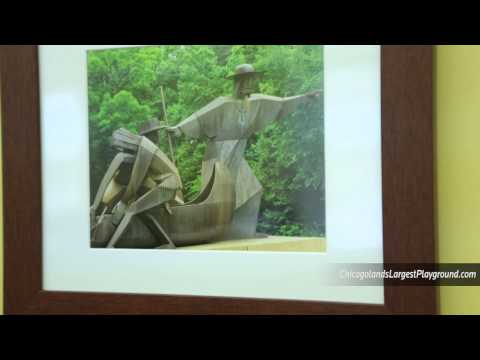
What is the cultural heritage of various immigrant communities in Joliet, Illinois? Joliet, a vibrant city located in the state of Illinois, has a rich history of welcoming immigrants from various parts of the world. These diverse communities have brought with them their unique cultural heritage, adding to the colorful tapestry of Joliet’s cultural landscape. As an authority on the subject, let’s delve into the cultural heritage of some of the prominent immigrant communities in Joliet.
1. Polish Community:
The Polish community has a strong presence in Joliet, with a significant number of Polish immigrants settling in the area. Their cultural heritage is deeply rooted in traditions such as Polska Kuchnia (Polish cuisine), folk music and dance, and religious celebrations. Joliet even has a Polish Constitution Day Parade, held annually in May, which showcases the community’s pride in their heritage.
2. Mexican Community:
The Mexican community in Joliet has made a lasting impact on the city’s cultural fabric. Immigrants from Mexico have brought their vibrant traditions, including traditional dances like the Jarabe Tapatío and celebrations like Dia de los Muertos (Day of the Dead). The Mexican community also adds a flavorful touch to Joliet’s culinary scene, with authentic Mexican restaurants and street food vendors.
3. Italian Community:
Joliet’s Italian community has a strong presence, with many Italian immigrants and their descendants calling the city home. Their cultural heritage is evident in the Italian festivals, such as the Festa Italiana, which celebrates Italian music, cuisine, and traditions. Italian cuisine, known for its pasta, pizza, and gelato, has also made its mark in Joliet, with numerous Italian restaurants serving up delicious dishes.
4. Irish Community:
The Irish community has a long-standing history in Joliet, with Irish immigrants arriving in the city as early as the 1800s. Their cultural heritage is celebrated through events like the St. Patrick’s Day Parade, showcasing Irish music, dance, and traditional attire. The Irish community has also contributed to Joliet’s cultural scene through their love for Irish literature, theater, and storytelling.
5. Lithuanian Community:
Joliet is home to a vibrant Lithuanian community, with immigrants from Lithuania preserving their cultural heritage in the city. The Lithuanian Heritage Club organizes events and activities that celebrate Lithuanian traditions, including folk dancing, music, and language classes. The Lithuanian community also takes pride in their rich culinary traditions, with dishes like kugelis (potato pudding) and cepelinai (potato dumplings) making appearances at community gatherings.
6. Greek Community:
The Greek community in Joliet has a strong presence, with Greek immigrants and their descendants contributing to the city’s cultural diversity. Greek festivals, such as the Taste of Greece, offer a glimpse into Greek traditions with music, dance, and mouthwatering Greek cuisine. The Greek community in Joliet also takes pride in their Greek Orthodox heritage, with beautiful churches and religious celebrations.
7. German Community:
The German community has left an indelible mark on Joliet’s cultural heritage. German immigrants brought their traditions, including Oktoberfest celebrations, German cuisine, and traditional music and dances. The German community’s influence can also be seen in the architecture of some historic buildings in Joliet, reflecting their German heritage.
In conclusion, Joliet, Illinois, is a melting pot of diverse immigrant communities, each contributing their unique cultural heritage to the city. From the Polish and Mexican communities to the Italian, Irish, Lithuanian, Greek, and German communities, Joliet embraces and celebrates the rich tapestry of cultures that have shaped its identity. The city’s festivals, cuisine, music, and traditions are a testament to the vibrant and diverse immigrant communities that call Joliet home.
The Melting Pot of Joliet: Unveiling the Vibrant Ethnic Tapestry of Illinois’ Hidden Gem
The Melting Pot of Joliet: Unveiling the Vibrant Ethnic Tapestry of Illinois’ Hidden Gem
Are you curious about the cultural heritage of various immigrant communities in Joliet, Illinois? Well, you’ve come to the right place! Joliet, often referred to as Illinois’ hidden gem, is a melting pot of diverse cultures and traditions. Let’s take a closer look at the vibrant ethnic tapestry that makes this city so unique.
1. Polish Heritage: Joliet is known for its strong Polish community, with Polish immigrants shaping the city’s cultural landscape. From traditional Polish cuisine like pierogis and kielbasa to lively polka festivals, the Polish heritage in Joliet is alive and thriving. You can explore the Polski Day Parade, where locals proudly display their Polish roots, or visit the Polish Museum of America to delve deeper into the history and contributions of the Polish community.
2. Mexican Influence: The Mexican community has also played a significant role in shaping Joliet’s cultural heritage. Vibrant festivals like Cinco de Mayo and Dia de los Muertos bring the streets of Joliet to life with colorful decorations, traditional dances, and mouthwatering Mexican cuisine. Don’t miss the chance to visit La Mexicana, a local market where you can find authentic Mexican ingredients and immerse yourself in the flavors of Mexico.
3. Irish Traditions: Joliet has a rich Irish heritage that is celebrated throughout the year. Whether it’s the annual St. Patrick’s Day parade or the Irish Fest, you’ll find plenty of opportunities to experience Irish music, dance, and cuisine. The Irish American Society of County Will hosts cultural events and offers language classes, providing a platform for locals to connect with their Irish roots.
4. Lithuanian Legacy: Joliet’s Lithuanian community has left an indelible mark on the city’s cultural fabric. The Lithuanian World Center is a hub for preserving and promoting Lithuanian traditions, language, and history. You can attend folk dance performances, art exhibits, and even take part in Lithuanian language classes. Don’t forget to try traditional Lithuanian dishes like cepelinai (potato dumplings) and kugelis (potato pudding) at local restaurants.
5. African American Contributions: Joliet’s African American community has made significant contributions to the city’s cultural heritage. The African American Cultural and Genealogical Society of Illinois hosts events that celebrate African American history, art, and music. From soul food restaurants to jazz clubs, Joliet offers a taste of African American culture that will leave you inspired.
In conclusion, Joliet, Illinois, is a hidden gem when it comes to its cultural heritage. The Polish, Mexican, Irish, Lithuanian, and African American communities have all played a vital role in shaping the city’s vibrant ethnic tapestry. From delicious cuisines to lively festivals and cultural centers, Joliet offers a truly diverse and enriching experience for anyone interested in exploring the cultural heritage of immigrant communities. So, why not plan a visit to Joliet and immerse yourself in this melting pot of cultures? You won’t be disappointed!
Discovering Joliet: Unveiling the Hidden Gems and Iconic Wonders That Make Illinois’ Joliet a Must-Visit Destination
Discovering Joliet: Unveiling the Hidden Gems and Iconic Wonders That Make Illinois’ Joliet a Must-Visit Destination is a comprehensive guide that explores the cultural heritage of various immigrant communities in Joliet, Illinois. This vibrant city is home to a rich tapestry of cultures, each with its own unique traditions, customs, and contributions to the community. From the early European settlers to more recent waves of immigration, Joliet has become a melting pot of diverse cultures that have left an indelible mark on the city’s heritage.
1.
Polish Heritage: Joliet has a strong Polish community that has played a significant role in shaping the city’s cultural landscape. The Polish community in Joliet is known for its vibrant festivals, such as the annual Polish Fest, where visitors can experience traditional Polish music, dance, and cuisine. The Polish Museum of America in Joliet is also a must-visit, showcasing the history and heritage of the Polish people in the region.
2. Mexican Influence: The Mexican community has made a lasting impact on the cultural fabric of Joliet. From mouthwatering Mexican cuisine to colorful celebrations like Cinco de Mayo and Day of the Dead, Joliet offers a glimpse into the rich traditions and customs of Mexico. The Hispanic Heritage Festival held in Joliet is a fantastic event that showcases the diverse cultures within the Mexican community, featuring traditional music, dance, and arts.
3. Irish Traditions: Joliet’s Irish community has preserved its heritage through various cultural events and organizations. The St. Patrick’s Day Parade in downtown Joliet is a highlight, where locals and visitors come together to celebrate Irish culture with music, dancing, and vibrant green decorations. The Irish American Society of County Will in Joliet is another hub for preserving and promoting Irish heritage through social events, language classes, and cultural exchanges.
4. Lithuanian Legacy: Joliet has a thriving Lithuanian community that has contributed to the city’s cultural diversity. The Lithuanian World Center in Joliet serves as a focal point for preserving Lithuanian traditions, hosting cultural events, and offering educational programs. The annual Lithuanian Days Festival is a must-visit, featuring traditional dances, music, and authentic Lithuanian cuisine.
5. African-American Heritage: Joliet’s African-American community has a rich history that is celebrated through various events and organizations. The African-American Cultural and Genealogical Society of Illinois in Joliet is dedicated to preserving and promoting African-American heritage through exhibits, workshops, and community outreach programs. The Joliet Area Historical Museum also showcases the contributions of African-Americans to the city’s history.
Joliet’s immigrant communities have woven a colorful tapestry of cultural heritage that adds a unique flavor to the city’s vibrant atmosphere. Exploring these various cultural influences will not only give you a deeper understanding of Joliet’s history but also allow you to appreciate the diverse traditions and customs that make this city a must-visit destination.
Unveiling the Rich Tapestry: Exploring the Fascinating History of Joliet City
Unveiling the Rich Tapestry: Exploring the Fascinating History of Joliet City
1. The Melting Pot of Immigrant Communities
Joliet, Illinois, has a long and vibrant history of welcoming immigrants from diverse backgrounds. The city’s cultural heritage is a rich tapestry woven from the threads of numerous immigrant communities. From the early European settlers to more recent waves of immigration, Joliet has been shaped by the contributions and traditions of various ethnic groups.
– European Roots: The city’s roots can be traced back to its early European settlers, primarily of French-Canadian and Irish descent. These communities played a significant role in establishing Joliet as a thriving industrial center in the 19th century. Their cultural heritage can still be seen in the architecture, traditions, and celebrations of the city.
– Hispanic Influence: The Hispanic community in Joliet has a deep cultural heritage, with Mexican, Puerto Rican, and other Latin American roots. The vibrant colors, flavors, and rhythms of their traditions are evident in the city’s festivals, cuisine, and artistic expressions. From the annual Mexican Independence Day celebration to the Dia de los Muertos festivities, Joliet embraces and celebrates its Hispanic heritage.
– African American Legacy: Joliet has a strong African American presence, with a heritage deeply rooted in the Great Migration of the early 20th century. African American communities have contributed significantly to the city’s cultural landscape, with their traditions, music, and arts playing a vital role in shaping Joliet’s identity.
– Asian Communities: Over the years, Joliet has become home to a growing Asian community, including individuals of Chinese, Indian, Filipino, and Korean descent, among others. These communities have enriched the city’s cultural fabric with their diverse traditions, languages, and culinary delights. From Lunar New Year celebrations to Indian dance performances, Joliet embraces the cultural heritage of its Asian residents.
2. Preserving and Celebrating Cultural Heritage
Joliet recognizes the importance of preserving and celebrating the cultural heritage of its immigrant communities. The city actively supports initiatives and organizations that promote cultural exchange, education, and understanding.
– Ethnic Festivals: Joliet hosts numerous ethnic festivals throughout the year, providing a platform for immigrant communities to showcase their traditions, music, dance, and cuisine. These festivals, such as the Irish Fest, Cinco de Mayo celebration, and Asian Heritage Festival, allow residents and visitors to immerse themselves in the rich cultural experiences of Joliet’s diverse communities.
– Cultural Centers: The city is home to various cultural centers that serve as gathering places for different immigrant communities. These centers provide resources, programs, and events that promote cultural awareness and understanding. They offer language classes, art exhibitions, workshops, and performances that highlight the unique heritage of each community.
– Historical Preservation: Joliet values its historical landmarks and strives to preserve them as a testament to its cultural heritage. Buildings, neighborhoods, and sites of historical significance are protected and maintained to ensure future generations can learn about the contributions and experiences of the city’s immigrant communities.
– Community Engagement: Joliet encourages community engagement and dialogue between different immigrant communities. Through town hall meetings, cultural exchange programs, and community events, residents have the opportunity to learn from one another, foster understanding, and build a stronger sense of unity.
In conclusion, the cultural heritage of various immigrant communities in Joliet, Illinois, is a vibrant tapestry that has shaped the city’s identity. From European settlers to more recent waves of immigration, Joliet embraces and celebrates its diverse heritage through festivals, cultural centers, historical preservation, and community engagement. Immigrant communities in Joliet have left an indelible mark on the city’s history, and their traditions continue to enrich the cultural fabric of this captivating Midwestern gem.
What is the cultural heritage of various immigrant communities in Joliet, Illinois? Joliet, Illinois, is a vibrant city that has been shaped by the contributions of numerous immigrant communities. These communities have brought with them their unique cultural heritage, which adds to the diversity and richness of the city.
**What are some of the prominent immigrant communities in Joliet?** Joliet is home to a diverse range of immigrant communities, including Mexican, Polish, Italian, Irish, and African-American communities, among others. Each community has its own distinct cultural traditions, languages, and customs that are passed down through generations.
**How has the Mexican community influenced the cultural landscape of Joliet?** The Mexican community, which is one of the largest immigrant communities in Joliet, has had a significant impact on the city’s cultural landscape. Mexican cuisine, music, and celebrations such as Cinco de Mayo and Day of the Dead have become an integral part of Joliet’s cultural fabric.
**What is the significance of the Polish community in Joliet?** The Polish community has a strong presence in Joliet and has contributed to the city’s cultural heritage through their traditions, music, and cuisine. Polish festivals, such as the Polish Fest, showcase the vibrant Polish culture and attract both locals and visitors.
**How has the Italian community shaped Joliet’s cultural identity?** The Italian community has played a significant role in shaping Joliet’s cultural identity. Italian cuisine, art, and music have become synonymous with the city, and events like the Italian-American Fest celebrate the rich Italian heritage.
**What contributions have the Irish made to Joliet’s cultural heritage?** The Irish community has made valuable contributions to Joliet’s cultural heritage. St. Patrick’s Day celebrations, Irish music and dance, and Irish pubs are all part of the vibrant Irish cultural scene in Joliet.
**What is the historical significance of African-American communities in Joliet?** African-American communities have a rich history in Joliet, dating back to the Great Migration. Their contributions to music, art, and civil rights have left a lasting impact on the city’s cultural heritage.
In conclusion, Joliet, Illinois, is a city with a diverse cultural heritage, thanks to the contributions of various immigrant communities. The Mexican, Polish, Italian, Irish, and African-American communities have all left their mark on the city’s cultural landscape, enriching it with their traditions, languages, and customs. The cultural diversity of Joliet is a testament to the strength and resilience of these communities and adds to the vibrant tapestry of the city.


